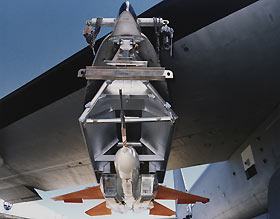
Save this image free of charge
in 800 pixels for layout use
(right click, Save as...)
|
|
Ref : S03985
Theme :
Aviation-NASA aircrafts-Prototypes (1538 images)
Title : F-15 RPRV Spin Research Vehicle (SRV) attached to B-52 pylon
Caption :
In this ground photo, one of the F-15 RPRV/SRVs is shown on the same pylon used for the X-15 and lifting body flights. The vehicle was a 3/8 scale model of the F-15 aircraft, and was designed for stall and spin research. The cost was $250,000 for each RPRV versus $6.8 million for an actual F-15. After being released from the B-52, the unpowered vehicle was flown by pilots on the ground, including Einar K. Envoldson, William H. Dana, Thomas C. McMurtry, John A. Manke, and Michael C. Swann. During the descent, the F-15 RPRV underwent tests of its stability and control, departure characteristics, spin evaluation at high and low altitude, upright and inverted spins, and different spin modes. On its first 16 flights, the F-15 RPRV was to be recovered in midair by a helicopter. The F-15 RPRV's parachute would be caught by ropes strung between two poles below the helicopter. Of the 16 attempts, 13 were successful, while the three other flights ended with parachute landings and varying amounts of damage. The F-15 RPRVs were then fitted with three retractable skids, which allowed the ground pilot to land the aircraft on the lakebed. Of the next 10 flights, nine were successful lakebed landings, while the other came down by parachute. After 26 flights, the aircraft was renamed the Spin Research Vehicle (SRV) and was used to test different nose configurations. The tests made on flights 27 through 52 were spin mode determination, auto-spin recovery, airflow visualization, the effects of strakes on vortex flow, aft pressure measurements, and a nose-mounted anti-spin parachute. The latter was unusual, as anti-spin parachutes are commonly mounted on the tail. During flight 36, on February 18, 1981, the nose-mounted parachute fouled the pitot tube after deployment. This forced a parachute landing, which was the only one in the SRV flights. The last RPRV/SRV flight was made on July 15, 1981. One of the vehicles has been restored and is on display at the Dryden Flight Research Center.
|
|

